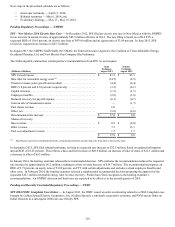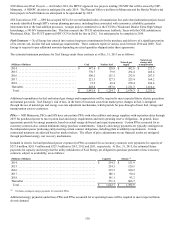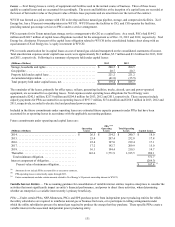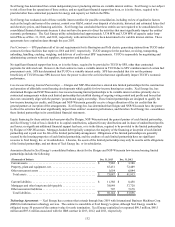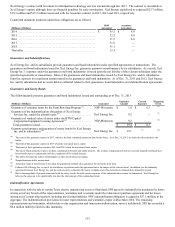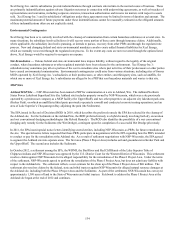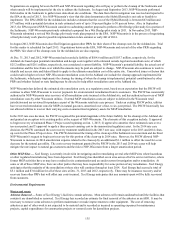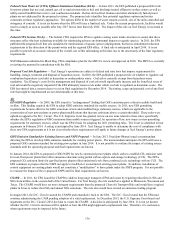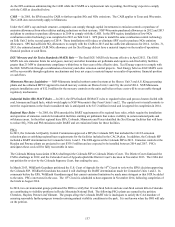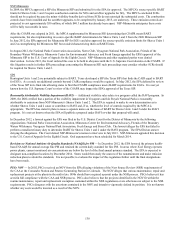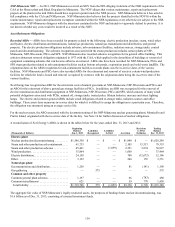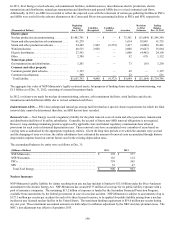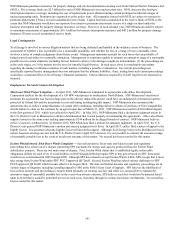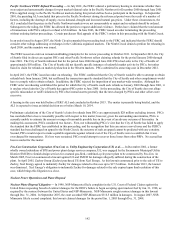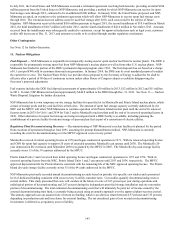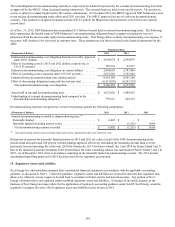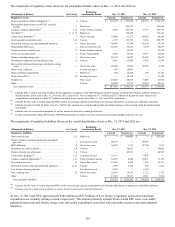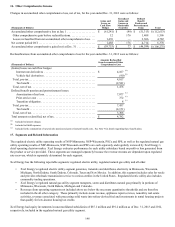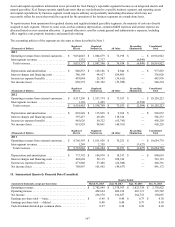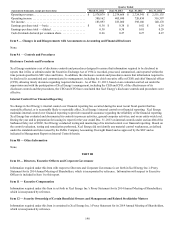Xcel Energy 2013 Annual Report Download - page 156
Download and view the complete annual report
Please find page 156 of the 2013 Xcel Energy annual report below. You can navigate through the pages in the report by either clicking on the pages listed below, or by using the keyword search tool below to find specific information within the annual report.
138
NSP-Minnesota
In 2009, the MPCA approved a SIP (the Minnesota SIP) and submitted it to the EPA for approval. The MPCA’s source-specific BART
limits for Sherco Units 1 and 2 require combustion controls for NOx and scrubber upgrades for SO2. The MPCA concluded SCRs
should not be required because the minor visibility benefits derived from SCRs do not outweigh the substantial costs. The combustion
controls have been installed and the scrubber upgrades, to be completed by January 2015, are underway. These emission controls are
projected to cost approximately $50 million, of which $40.3 million has already been spent. NSP-Minnesota anticipates these costs
will be fully recoverable in rates.
After the CSAPR was adopted in 2011, the MPCA supplemented its Minnesota SIP, determining that CSAPR meets BART
requirements, but also implementing its source-specific BART determination for Sherco Units 1 and 2 from the 2009 Minnesota SIP.
In June 2012, the EPA approved the Minnesota SIP for EGUs and also approved the source-specific emission limits for Sherco Units 1
and 2 as strengthening the Minnesota SIP, but avoided characterizing them as BART limits.
In August 2012, the National Parks Conservation Association, Sierra Club, Voyageurs National Park Association, Friends of the
Boundary Waters Wilderness, Minnesota Center for Environmental Advocacy and Fresh Energy appealed the EPA’s approval of the
Minnesota SIP to the U.S. Court of Appeals for the Eighth Circuit. NSP-Minnesota and other regulated parties were denied
intervention. In June 2013, the Court ordered this case to be held in abeyance until the U.S. Supreme Court decides on the CSAPR. If
this litigation results in further EPA proceedings concerning the Minnesota SIP, such proceedings may consider whether SCRs should
be required for Sherco Units 1 and 2.
SPS
Harrington Units 1 and 2 are potentially subject to BART. Texas developed a SIP (the Texas SIP) that finds the CAIR equal to BART
for EGUs. As a result, no additional controls beyond CAIR compliance would be required. In May 2012, the EPA deferred its review
of the Texas SIP in its final rule allowing states to find that CSAPR compliance meets BART requirements for EGUs. It is not yet
known how the U.S. Supreme Court’s review of the CSAPR may impact the EPA’s approval of the Texas SIP.
Reasonably Attributable Visibility Impairment (RAVI) — Additional visibility rules relate to a program called the RAVI program. In
2009, the DOI certified that a portion of the visibility impairment in Voyageurs and Isle Royale National Parks is reasonably
attributable to emissions from NSP-Minnesota’s Sherco Units 1 and 2. The EPA is required to make its own determination as to
whether Sherco Units 1 and 2 cause or contribute to RAVI and, if so, whether the level of controls required by the MPCA is
appropriate. The EPA has stated it plans to issue a separate notice on the issue of BART for Sherco Units 1 and 2 under the RAVI
program. It is not yet known when the EPA will publish a proposal under RAVI or what that proposal will entail.
In December 2012, a lawsuit against the EPA was filed in the U.S. District Court for the District of Minnesota by the following
organizations: National Parks Conservation Association, Minnesota Center for Environmental Advocacy, Friends of the Boundary
Waters Wilderness, Voyageurs National Park Association, Fresh Energy and Sierra Club. The lawsuit alleges the EPA has failed to
perform a nondiscretionary duty to determine BART for Sherco Units 1 and 2 under the RAVI program. The EPA filed an answer
denying the allegations. The Court denied NSP-Minnesota’s motion to intervene in July 2013. NSP-Minnesota appealed this decision
to the U.S. Court of Appeals for the Eighth Circuit. Oral arguments have been scheduled for March 2014.
Revisions to National Ambient Air Quality Standards (NAAQS) for PM — In December 2012, the EPA lowered the primary health-
based NAAQS for annual average fine PM and retained the current daily standard for fine PM. In areas where Xcel Energy operates
power plants, current monitored air concentrations are below the level of the final annual primary standard. The EPA is expected to
designate non-compliant locations by December 2014. States would then study the sources of the nonattainment and make emission
reduction plans to attain the standards. It is not possible to evaluate the impact of this regulation further until the final designations
have been made.
PSCo NOV — In 2002, PSCo received an NOV from the EPA alleging violations of the New Source Review (NSR) requirements of
the CAA at the Comanche Station and Pawnee Generating Station in Colorado. The NOV alleges that various maintenance, repair and
replacement projects at the plants in the mid to late 1990s should have required a permit under the NSR process. PSCo believes it has
acted in full compliance with the CAA and NSR process. PSCo also believes that the projects identified in the NOV fit within the
routine maintenance, repair and replacement exemption contained within the NSR regulations or are otherwise not subject to the NSR
requirements. PSCo disagrees with the assertions contained in the NOV and intends to vigorously defend its position. It is not known
whether any costs would be incurred as a result of this NOV.


